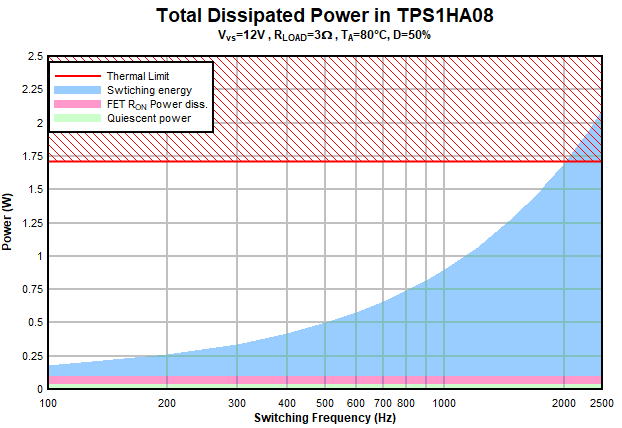SLVAF10 March 2021 TPS1H000-Q1 , TPS1H100-Q1 , TPS1H200A-Q1 , TPS1HA08-Q1 , TPS1HB08-Q1 , TPS1HB16-Q1 , TPS1HB35-Q1 , TPS1HB50-Q1 , TPS2H000-Q1 , TPS2H160-Q1 , TPS2HB16-Q1 , TPS2HB35-Q1 , TPS2HB50-Q1 , TPS4H000-Q1 , TPS4H160-Q1
2 Device Thermals
Thermal limits of any IC should always be kept in mind, and this is especially true for high-side switches which are often asked to switch large currents to the load.
We can estimate the total power dissipated by the device itself by summing power dissipation due to the FET RON, switching losses, and quiescent power.
We can calculate power dissipated in the HSS FET as in Equation 1. This power is proportional to the on-resistance (specified in the device datasheet) and the average current through the FET.





| RΘJA | Junction-to-ambient thermal resistance |
| RΘJB | Junction-to-board thermal resistance |
| RΘJC | Junction-to-case thermal resistance. |
TI HSSs utilize a thermal pad which is recommended to be soldered directly to the PCB. This benefits devices thermals by utilizing the large surface area of the attached thermal plane as a heatsink, which closely couples with board temperature. Board temperature, however, is difficult to measure accurately and is highly dependent on board construction and solder coverage/quality on the high side switch. Ambient temperature, on the other hand, is easier to measure and straightforward to use in junction temperature estimation.
For a given ambient temperature the operating junction temperature may be estimated as below.


 Figure 2-1 Power Dissipation Sources in TPS1HA08
Figure 2-1 Power Dissipation Sources in TPS1HA08